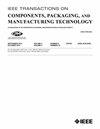On-Chip Single-/Dual-Notch-Band Half-Mode Substrate Integrated Plasmonic Waveguide Filters Based on Through Glass Via Technology
IF 2.3
3区 工程技术
Q2 ENGINEERING, ELECTRICAL & ELECTRONIC
IEEE Transactions on Components, Packaging and Manufacturing Technology
Pub Date : 2025-03-07
DOI:10.1109/TCPMT.2025.3549037
引用次数: 0
Abstract
In this letter, a series of on-chip millimeter-wave (mm-W) notch-band half-mode substrate integrated plasmonic waveguide (HMSIPW) filters based on wafer-level through glass via (TGV) technology are realized, which features wideband and ultralow loss. Based on the analysis of the dispersion characteristics of the HMSIPW unit, the design mechanism of the single-band HMSIPW filter is studied. Furthermore, this work proposes the first integration of complementary split-ring resonator (CSRR)-based defected ground structure (DGS) with HMSIPW through TGV technology, enabling compact and tunable notch-band filtering in the mm-W regime. The unique combination of glass substrate and spoof surface plasmon polaritons (SSPPs) achieves ultralow insertion loss and independent control of center frequencies and bandwidths (BWs), surpassing prior works in both miniaturization and functional flexibility. To validate the proposed design methodology, three glass-based HMSIPW filter prototypes are fabricated and tested. The results show a good filtering performance. The number of notch band can be changed by adjusting the parameters of CSRR. The center frequencies and BWs can also be independently controlled. The proposed HMSIPW filters with good performance may have potential applications in mm-W wireless communication systems.基于玻璃通孔技术的片上单/双陷口带半模基板集成等离子波导滤波器
在本文中,实现了一系列基于晶圆级玻璃通孔(TGV)技术的片上毫米波(mm-W)陷波带半模衬底集成等离子波导(HMSIPW)滤波器,具有宽带和超低损耗的特点。在分析HMSIPW单元色散特性的基础上,研究了单波段HMSIPW滤波器的设计机理。此外,这项工作提出了通过TGV技术首次将基于互补裂环谐振器(CSRR)的缺陷接地结构(DGS)与HMSIPW集成在一起,实现了mm-W范围内紧凑可调的陷波带滤波。玻璃基板和欺骗表面等离子激元(SSPPs)的独特组合实现了超低插入损耗和中心频率和带宽(BWs)的独立控制,在小型化和功能灵活性方面都超越了先前的工作。为了验证提出的设计方法,制作了三个基于玻璃的HMSIPW滤波器原型并进行了测试。结果表明,该方法具有良好的滤波性能。通过调整CSRR的参数,可以改变陷波带的数量。中心频率和bw也可以独立控制。该滤波器具有良好的性能,在毫米波无线通信系统中具有潜在的应用前景。
本文章由计算机程序翻译,如有差异,请以英文原文为准。
求助全文
约1分钟内获得全文
求助全文
来源期刊

IEEE Transactions on Components, Packaging and Manufacturing Technology
ENGINEERING, MANUFACTURING-ENGINEERING, ELECTRICAL & ELECTRONIC
CiteScore
4.70
自引率
13.60%
发文量
203
审稿时长
3 months
期刊介绍:
IEEE Transactions on Components, Packaging, and Manufacturing Technology publishes research and application articles on modeling, design, building blocks, technical infrastructure, and analysis underpinning electronic, photonic and MEMS packaging, in addition to new developments in passive components, electrical contacts and connectors, thermal management, and device reliability; as well as the manufacture of electronics parts and assemblies, with broad coverage of design, factory modeling, assembly methods, quality, product robustness, and design-for-environment.
 求助内容:
求助内容: 应助结果提醒方式:
应助结果提醒方式:


